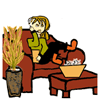Aging in Place: Adapting Homes for Veterans
Published in Home Articles
How can a home be safer and more comfortable as needs change?
For veterans, adapting a living space allows for greater independence and ease in daily life. Simple upgrades like wider doorways, grab bars, and better lighting can make a big difference.
Ramps and stairlifts help with mobility, while smart technology offers added convenience. Every adjustment supports a better quality of life, making it easier to stay in a familiar place.
With the right changes, a home becomes a space that works for every stage of life. Ready to explore the best ways to create a safer home?
Improving Accessibility
A home should be easy to move around in at any age. Wider doorways help with wheelchairs and walkers. Ramps make it easier to enter and leave without using stairs.
Door and faucet handles should be simple to use. Lower counters and shelves help reach things without trouble. Hallways should be wide enough to walk through safely. Smooth floors with no high edges help prevent trips.
Railings along pathways add support, especially outside. These changes make living at home easier and safer. For extra help with daily needs, DVA home care services can provide support to keep the home safe and comfortable.
Enhancing Bathroom Safety
A bathroom should be easy to use and safe for daily routines. Slippery floors can cause falls, so non-slip mats or textured tiles help prevent accidents. Grab bars near the toilet and shower provide extra support when sitting or standing.
A walk-in shower with a sturdy seat makes bathing easier. Hand-held showerheads offer better control, while anti-scald faucets prevent burns. A raised toilet seat reduces strain on the knees and back.
Good ventilation keeps the space dry to avoid mold and mildew. Small changes like these create a safer space for everyday use. With the right adjustments, it becomes easier to move with confidence and feel safe in the home.
Upgrading Lighting and Flooring
Good lighting helps prevent falls and makes daily tasks easier. Adding more lights in hallways, doorways, and stairs makes it easier to see. Motion-sensor lights turn on by themselves, so there is no need to find a switch.
Nightlights in bedrooms and bathrooms help in the dark. Floors should be smooth but not slippery. Low-pile carpets and non-slip rugs help prevent trips.
Removing loose rugs and uneven flooring makes walking safer. These changes make moving around easier and help create a safe and comfortable home.
Integrating Smart Home Technology
New technology can make daily life easier. Voice-controlled devices turn lights on and off, change the temperature, or play music without pressing buttons. Smart door locks make it easy to enter without keys.
Video doorbells show who is at the door before opening it. Smart speakers can give reminders for medicine or appointments. Motion-sensor lights turn on when someone walks into a room.
These simple tools help make a home more comfortable and easy to use. With the right changes, daily tasks become easier while keeping the home safe and convenient.
Creating a Safe and Comfortable Home for Every Stage of Life
Making the right changes at home helps veterans stay independent and comfortable as they age. Simple upgrades like ramps, grab bars, better lighting, and smart technology create a safer living space.
These adjustments support daily needs while allowing for greater ease and mobility. A well-adapted home makes everyday life simpler and more secure, ensuring a familiar and comfortable place to live for years to come. Small changes today can make a big difference tomorrow.
Did you find this article helpful? Visit our website for more awesome content like this.





























Comments